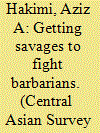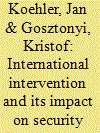| Srl | Item |
| 1 |
ID:
124155


|
|
|
|
|
| Publication |
2013.
|
| Summary/Abstract |
This article focuses on the emergence and evolution of the Afghan Local Police (ALP), a pro-government militia supported by the US military in Wardak Province. The ALP and its previous incarnations have been justified, invoking notions of 'local solutions' and 'cost-effectiveness', as a politically convenient and culturally appropriate measure to supplement broader efforts to counter the insurgency and build up the regular forces. Inspired by the tribal policing concept of arbaki, ALP was envisaged as a short-term local defence force. But the programme has been controversial, and its impact in improving security questionable. In analysing the contestations between different actors involved in the programme, the article demonstrates that the US military's attempt to resuscitate 'age-old traditions' of self-protection proved difficult to realize and produced unforeseen and largely deleterious outcomes. It concludes that far from reflecting the needs of local villagers, ALP was a top-down imposition whose objectives were much narrower than the purported aim of protecting the local population in Wardak.
|
|
|
|
|
|
|
|
|
|
|
|
|
|
|
|
| 2 |
ID:
133140


|
|
|
|
|
| Publication |
2014.
|
| Summary/Abstract |
The challenge of building a security sector effective in terms of protecting the population and the state from challengers, and which at the same time fulfils minimum standards of good governance, was a daunting one in Afghanistan. These difficulties were compounded by what in hindsight seem to be obvious mistakes on the part of the intervention. In our paper, we investigate how security sector building fared under such adverse conditions in north-east Afghanistan. We find that in spite of the formidable challenges and the mistakes made by the international intervention, it did not fail completely. Neither did it succeed. Based on the results of quantitative surveys and qualitative research, we suggest that (a) the international intervention was partly successful in building up Afghan National Security Forces - both as a fighting force and in terms of security sector institutions that are restrained to some extent by the rule of law; (b) the problems caused by setting up informal local militias (violent feuds, criminality, human rights abuses and extortion of the population) could be partly mitigated by transforming them into an official local police programme.
|
|
|
|
|
|
|
|
|
|
|
|
|
|
|
|